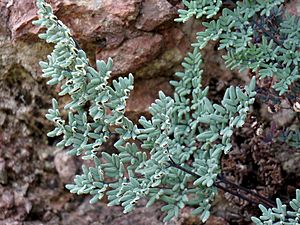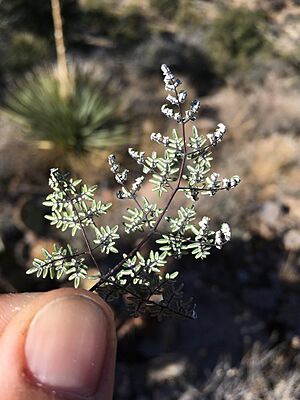Southwestern false cloak fern facts for kids
Quick facts for kids Southwestern false cloak fern |
|
|---|---|
 |
|
| Fronds of southwestern false cloak fern growing from a rocky niche | |
| Conservation status | |
| Scientific classification | |
| Genus: |
Argyrochosma
|
| Species: |
limitanea
|
| Subspecies | |
|
|
| Synonyms | |
|
|
The southwestern false cloak fern (Argyrochosma limitanea) is a type of fern. It grows naturally in the southwestern United States and Sonora, Mexico. You can often find it on rocks that contain calcium.
This fern has small leaves that are divided into many tiny parts. The leaves feel a bit like leather. The stems connecting the leaf parts are dark. The underside of the leaves has a thick white powder. This fern reproduces in a special way called apogamy. There are two main types, or subspecies, of this fern. Scientists think they might have formed from different parent plants. This fern was first named in 1919. In 1987, it was moved into a new group called Argyrochosma, known as the "false cloak ferns."
Contents
What Does This Fern Look Like?
The southwestern false cloak fern has a short, horizontal rhizome. This is like an underground stem. Its leaves grow close together from this rhizome. The rhizome has thin, brown scales that are smooth on the edges.
The leaves can be from about 5 to 30 centimeters (2 to 12 inches) long. The stipe is the stalk that holds the leaf blade. It is reddish-brown to black and smooth. It is about 3 to 12 centimeters (1 to 5 inches) long. This makes up about one-third to one-half of the leaf's total length.
The leaf blades are about 2.5 to 11 centimeters (1 to 4 inches) long. They can be triangular or more narrow. The blades are very divided, sometimes up to five times at the base. The main stem of the leaf, called the rachis, is dark and smooth. The dark color continues into the base of the leaf segments. There are 6 to 12 pairs of main leaf branches, called pinnae.
The leaf segments are small and grow close together. They can be oval, round, or oblong. The leaf tissue feels like leather. You can't easily see the veins on the top surface. The underside of the leaf has a thick layer of white powder, called farina. When the fern dries out, its leaves and stems curl upwards.
How This Fern Reproduces
On fertile leaf segments, the sporangia are found near the edges. Sporangia are tiny cases that hold spores. Each sporangium has 32 spores. The leaf segments often curl under, hiding the sporangia. This fern reproduces without needing two parents. It is a triploid, meaning it has three sets of chromosomes.
Different Types of Southwestern False Cloak Fern
There are two main types, or subspecies, of this fern:
- A. limitanea subsp. limitanea: This type has wider leaf blades (2 to 6 cm or 1 to 2 inches). Its blades are more triangular and divided 4 to 5 times at the base. The lowest leaf branches are at least half the length of the whole leaf.
- A. limitanea subsp. mexicana: This type has narrower leaf blades (1 to 2.5 cm or 0.4 to 1 inch). Its blades are more spear-shaped or oblong. They are divided 3 to 4 times at the base. The lowest leaf branches are about one-third to one-quarter the length of the whole leaf.
You can tell A. limitanea apart from other similar ferns because its dark stem color continues into the base of its leaf segments. It is also generally larger than the A. dealbata, with darker stems and thicker leaves.
Where Does This Fern Live?
The southwestern false cloak fern grows in the United States from San Bernardino County, California, across Arizona, New Mexico, southern Utah, and Trans-Pecos Texas. It also grows south into northern Mexico, reaching as far as Hidalgo.
- A. limitanea subsp. limitanea is found from California through Utah and into Mexico in Sonora and Chihuahua.
- A. limitanea subsp. mexicana lives more to the east, from Arizona through Texas and in Mexico from Chihuahua and Sinaloa eastward.
Both subspecies grow on rocky slopes and cliffs. These rocks can be made of limestone or volcanic material. However, A. limitanea subsp. mexicana prefers limestone rocks more in Mexico.
- A. limitanea subsp. limitanea is found at heights from about 800 to 2,300 meters (2,600 to 7,500 feet).
- A. limitanea subsp. mexicana grows in the mountains at heights from about 1,500 to 2,500 meters (4,900 to 8,200 feet).
Conservation Status
The Argyrochosma limitanea fern is generally considered "apparently secure" by the NatureServe conservation status system. This means it is not in immediate danger. However, in Texas, it is thought to be "imperiled," meaning it is at risk there.



